Successful ecommerce businesses sell products and services that fill a market gap or solve a problem. They have the potential to generate income because they fulfill a need.
According to a 2023 Statista survey, 43% of U.S. consumers bought clothes online, 33% purchased shoes, and 26% ordered food or beverages online. Shoppers also bought pet products, electronics, and toys. And 18% of consumers said they purchased drugstore and health products online.
However, if you start a business with no potential for growth, your hard work will be in vain. One of the first things to focus on is finding a niche with high income potential. To help you out, we’ve compiled a list of the 15 best ecommerce businesses to start in 2024.
Let’s dive in.
Start an Online Consulting Business
Whether you're an accountant, a dietician, or a software developer, you can sell your skills online. One way to do that is to start a consulting business.
The marketing consulting industry reached an estimated $78.2 billion in 2023. This field has a low barrier to entry (you only need the right skills to get started) and offers plenty of growth opportunities.
Depending on your abilities, you could assist clients with their digital marketing, operations, or SEO needs. You could work with small- to medium-sized businesses, nonprofits, or global enterprises in specific industries like healthcare or manufacturing.
Or, work with everyday people on something more personal like parenting or life coaching.

Further reading: The 25 Best Small Business Ideas for Budding Entrepreneurs
Create and Sell Online Courses
If, say, you're a personal trainer, you could teach people how to develop an exercise habit, set up a home gym, or create an exercise plan. Then publish your courses on your website or on dedicated platforms like Udemy and Teachable.
A good example is this Udemy course called "Science-Based Bodyweight Workout: Build Muscle without a Gym." It has more than 1,550 reviews and 12,700 students, and it's earned 4.5 out of 5 stars.
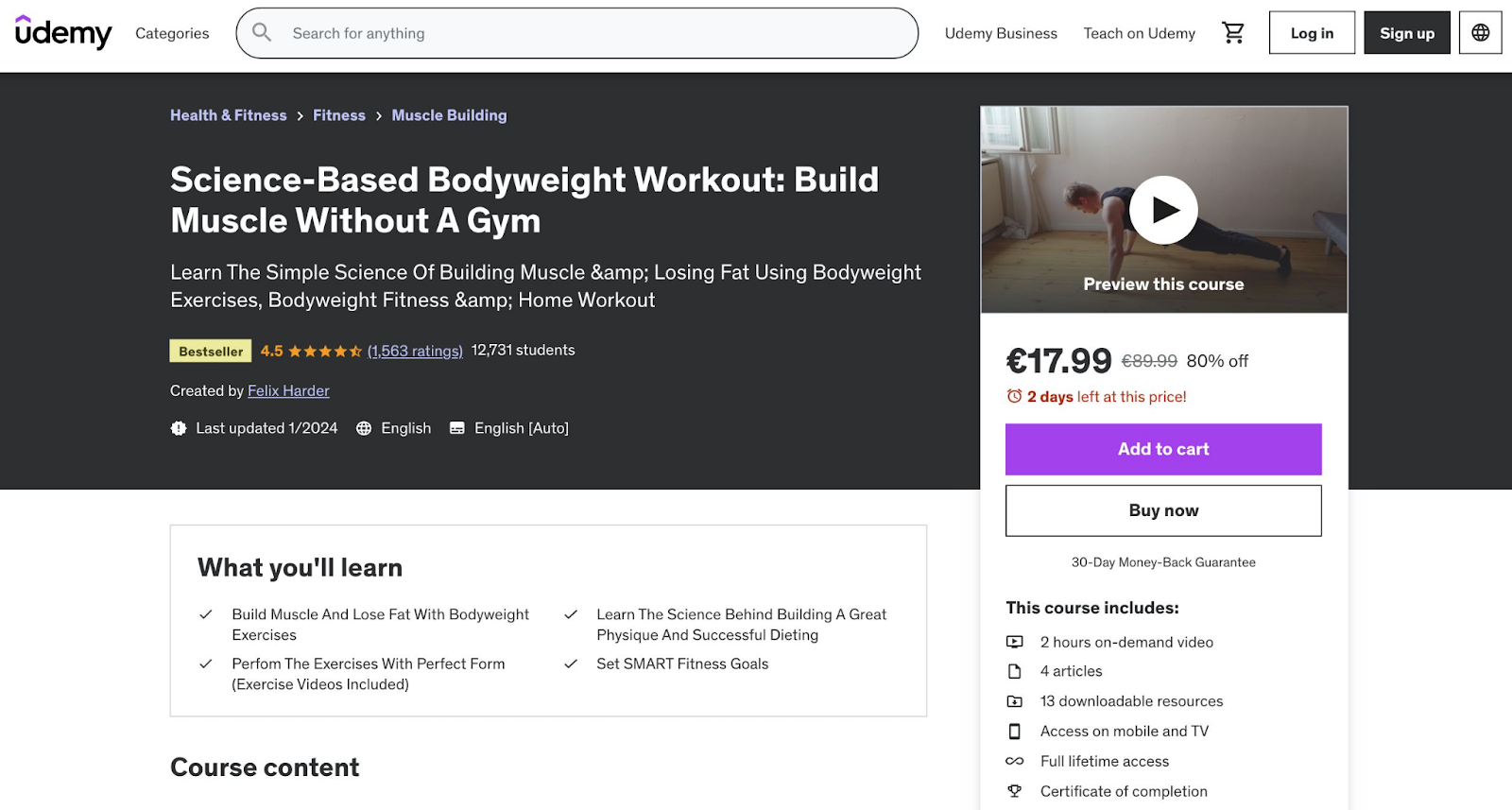
Selling on online learning platforms allows you to reach thousands of potential customers. Your website may not get the same level of exposure, especially if it's new.
Monetize Your Content
Turn your website and social media content into a passive income stream. For example, monetize your blog with Google Adsense, sponsored content, or affiliate marketing.
Another option is to set up a members-only area on your website featuring exclusive content. If, say, you're a beauty expert, create and share makeup tutorials that resonate with your target audience.
You could also start a paid newsletter on Substack or Memberful, or share your content on Patreon to earn passive income from subscriptions.
Below is an example of a paid newsletter about history. It currently has over 1,300,000 subscribers and three subscription plans starting at $5 per month.
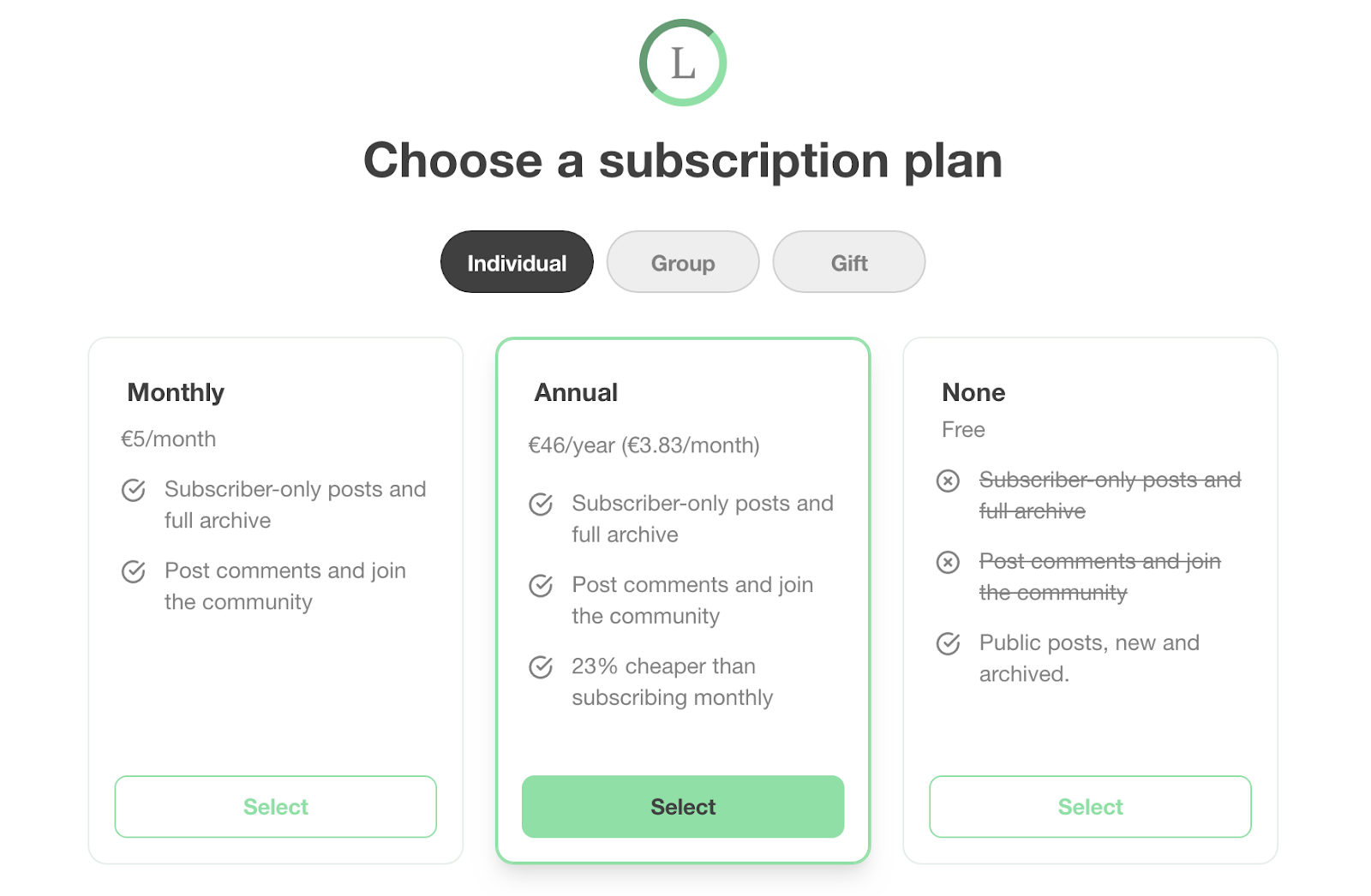
The above newsletter generates around $5 million per year based on the number of subscribers. The second and third most popular newsletters on Substack bring in $1.5 million and have tens of thousands of readers.
Sell Niche Apparel
Per Statista research, 43% of consumers purchased clothes over the internet in 2023.
Without a doubt, the apparel market has a lot of potential but is highly competitive. However, you can sell niche products to set your business apart.
A niche market is a small segment within a larger market. Smaller markets appeal to consumers looking for specific products or services within a larger market.
Let's say you want to sell leather jackets, which is highly competitive. To narrow down your niche, offer leather jackets for vintage enthusiasts, bikers, or customers interested in punk, rock, or gothic fashion.
If you start a clothing business, you could focus on plus-size fashion, sportswear, or other niches, such as:
- Goth and alternative clothing
- High-end luxury fashion
- Sustainable apparel
- Unisex clothing
- Vintage clothing
- Maternity wear
- Workwear
- Special interest (a video game, cult movie, fringe TV show)
The unisex clothing market is expected to reach $3.2 billion by 2030.
Young people are more open-minded about gender roles than previous generations, and many have embraced gender fluidity. Therefore, selling unisex clothing, like The Phluid Project, may be a viable business idea.
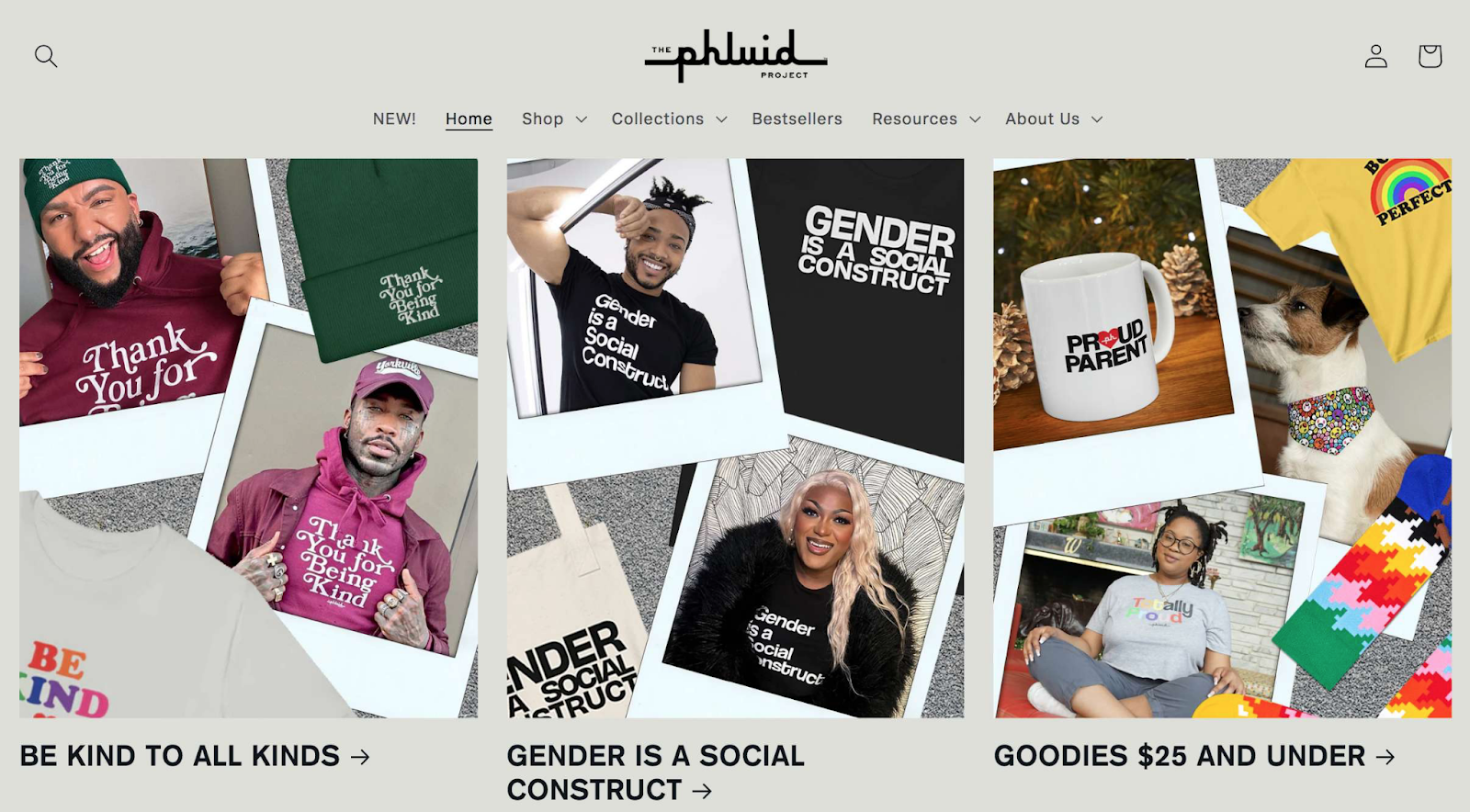
Breaking into the fashion business requires some resources to start. You might have to purchase inventory, a storage location, and more.
Instead, consider print on demand (POD). Create custom apparel without holding inventory or even fulfilling customer orders.
Start a Print-on-Demand Business
The POD market was worth $6.18 billion in 2022, and its popularity is rising due to the demand for custom products. Plus, this type of ecommerce business requires little or no investment to start.
Create designs and print them on tshirts, sweatshirts, leggings, or other items like canvas prints, car mats, mousepads, and more.
You don't have to spend thousands to hold inventory. Companies like Redbubble, Printify, Printful, and Modalyst create and print the products with your designs and then ship them directly to customers.
For instance, the global online marketplace Redbubble enables users to monetize their artwork. Set up an online shop on their platform, upload your designs, and display them on over 70 products, from T-shirts and mugs to duffle bags.
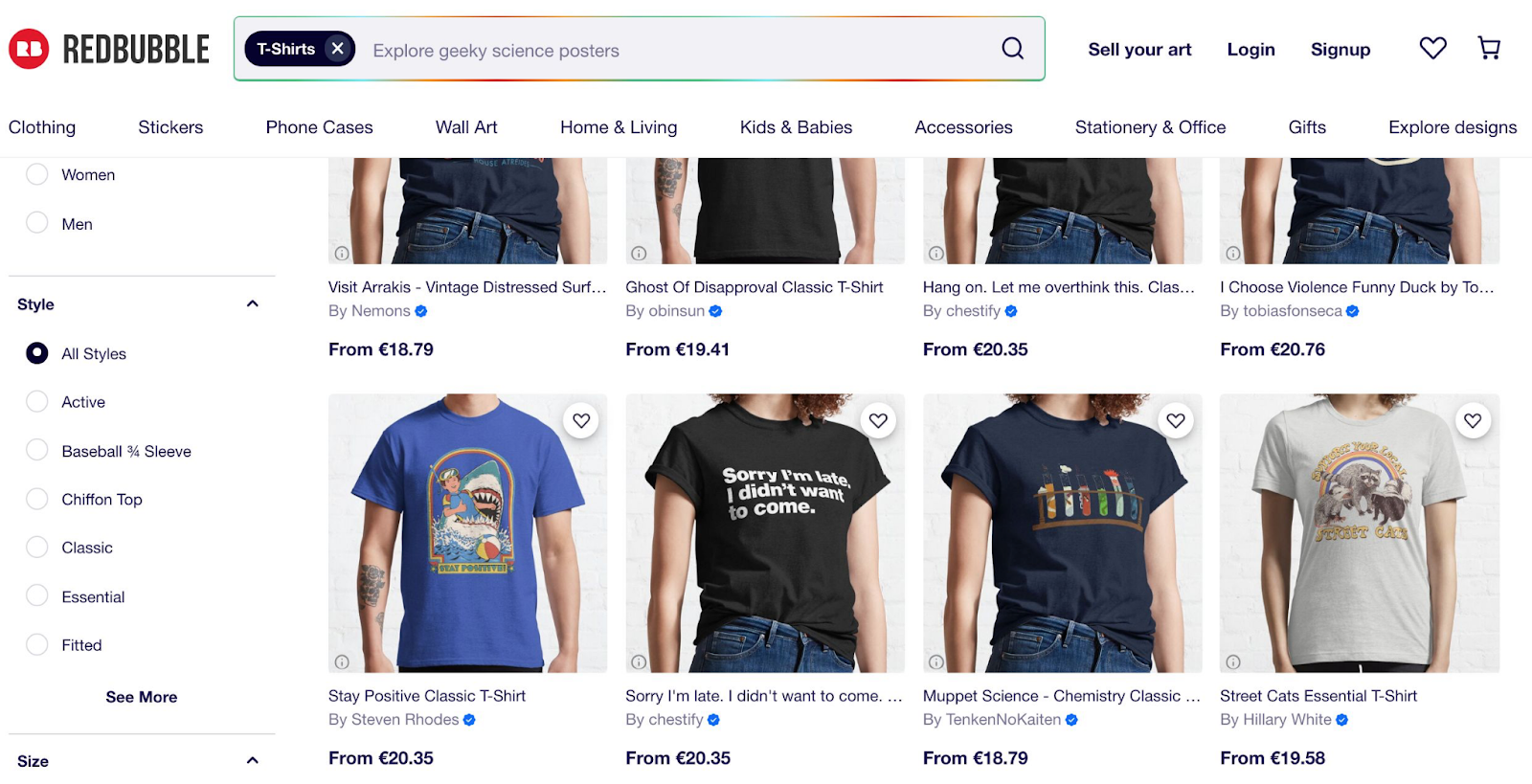
Redbubble pays once a month and allows you to set your own profit margins and prices.
Sell Printables on Etsy
This ecommerce idea requires little to no initial investment. Consider selling digital printables on a platform like Etsy. All it takes is a bit of creativity, business acumen, and basic design skills.
Printables are digital cards, to-do lists, planners, calendars, and similar items created with Canva or other graphic design tools. Consumers can edit and print them at home.
For example, you could sell printable wedding invitations like these:
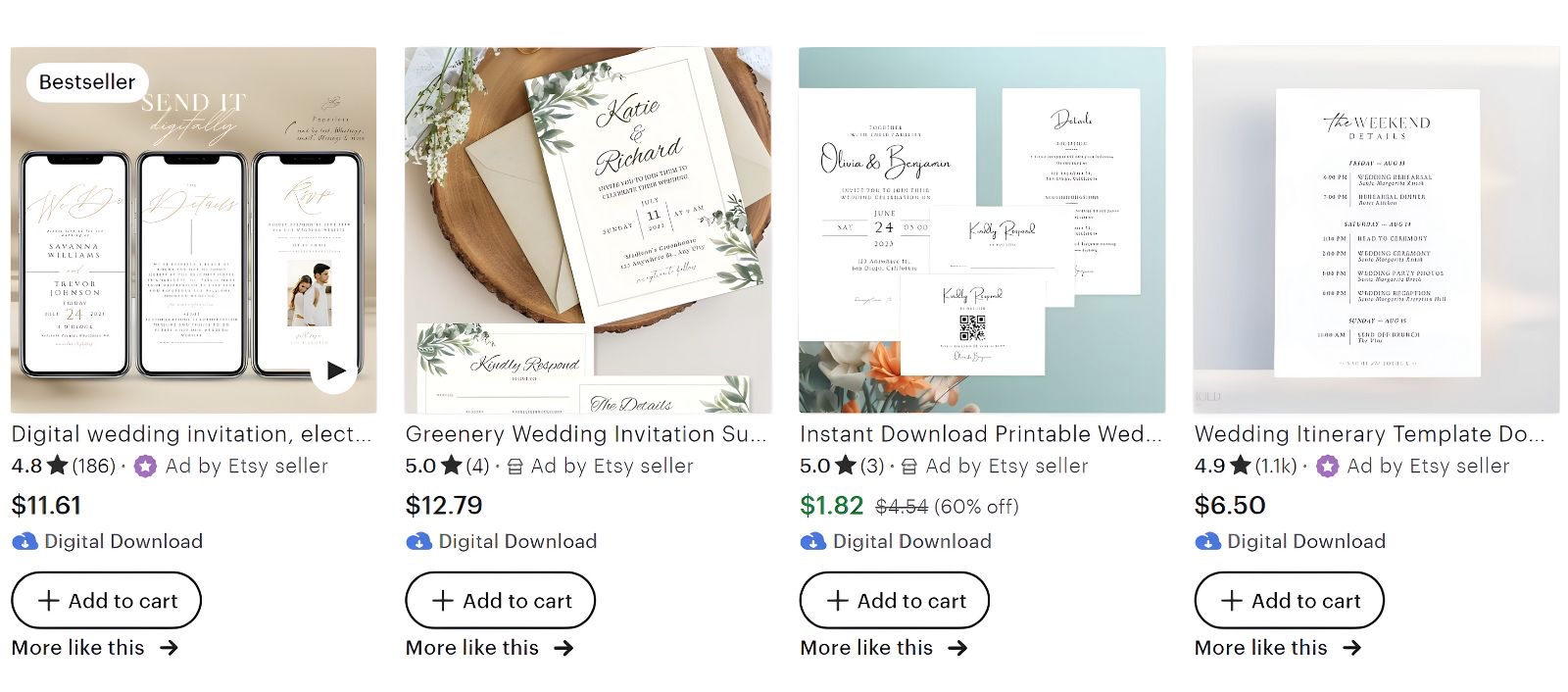
In 2022, CNBC published an article about Rachel Jimenez, a young mother who made around $160,000 in just one year selling printables on Etsy.
Today, her online store offers nearly 400 products, from printable games and business templates to legal contracts and thank-you cards.
You can also sell printables on Amazon, eBay, Gumroad, and other online marketplaces.
Sell Handmade Items
The global handmade market was worth $678.24 billion in 2022, and it's expected to reach $983.12 billion by 2030. Leverage this trend to turn your passion into a lucrative business.
You could sell handmade jewelry, cosmetics, candles, woodwork, leather bags, and more. Bespoke, handcrafted items often have a higher perceived value than mass-produced goods due to their uniqueness and quality.
Display your work on a dedicated marketplace like Etsy, Amazon Handmade, or IndieCart. These online platforms are popular among buyers who love handmade products. So it will be easier to reach your target market.
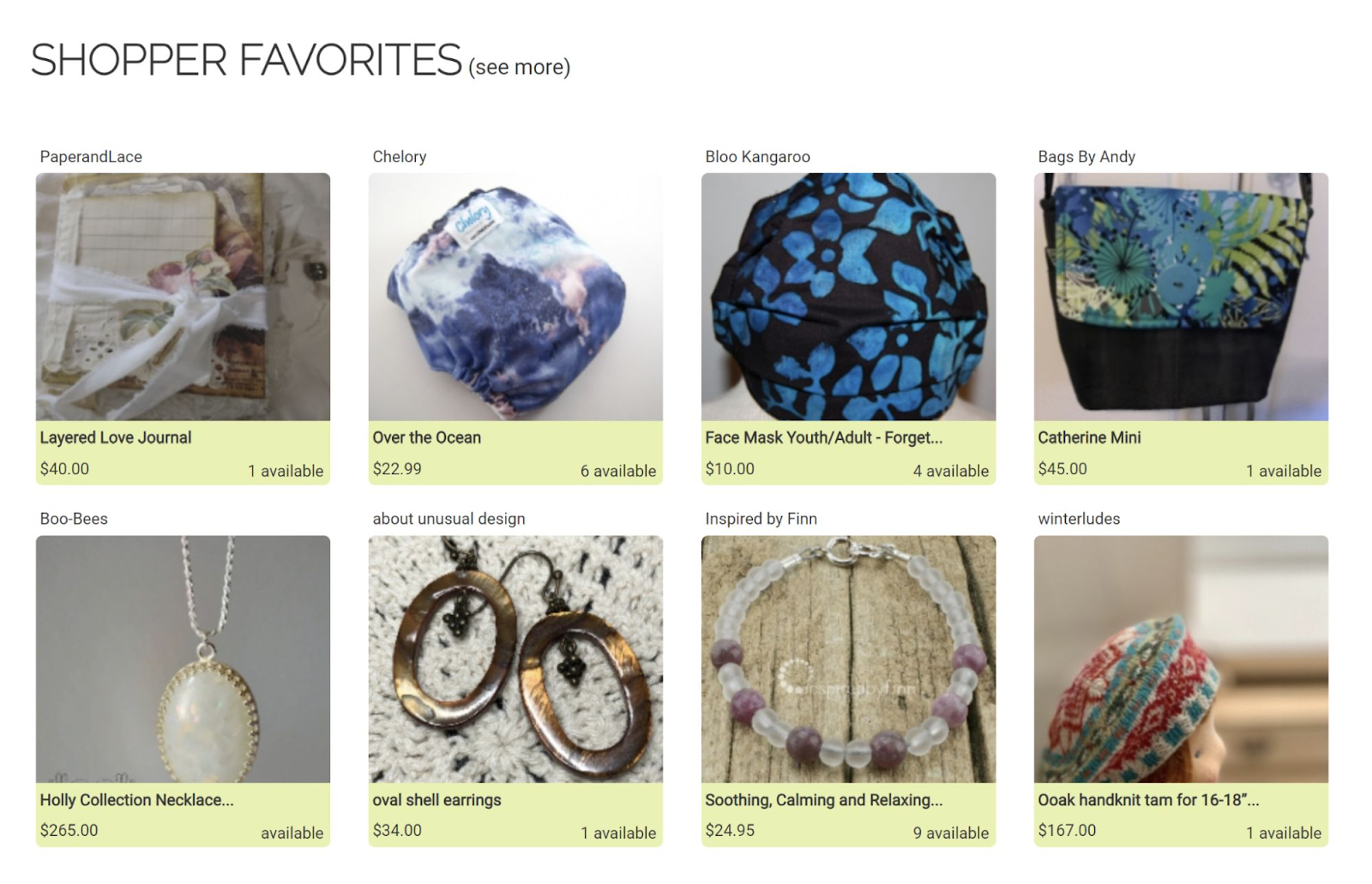
Start a Clothing Rental Business
You've likely bought dresses, suits, or coats you only wore once or twice. You may have needed a fancy dress for a party or a formal suit for a business conference. But what if you could rent instead of buying these seldom-used clothing items to save money (and closet space)?
With this business model, you rent out clothes for special events, photoshoots, weddings, or everyday wear. List the products on your website or use dedicated platforms like HURR or By Rotation.
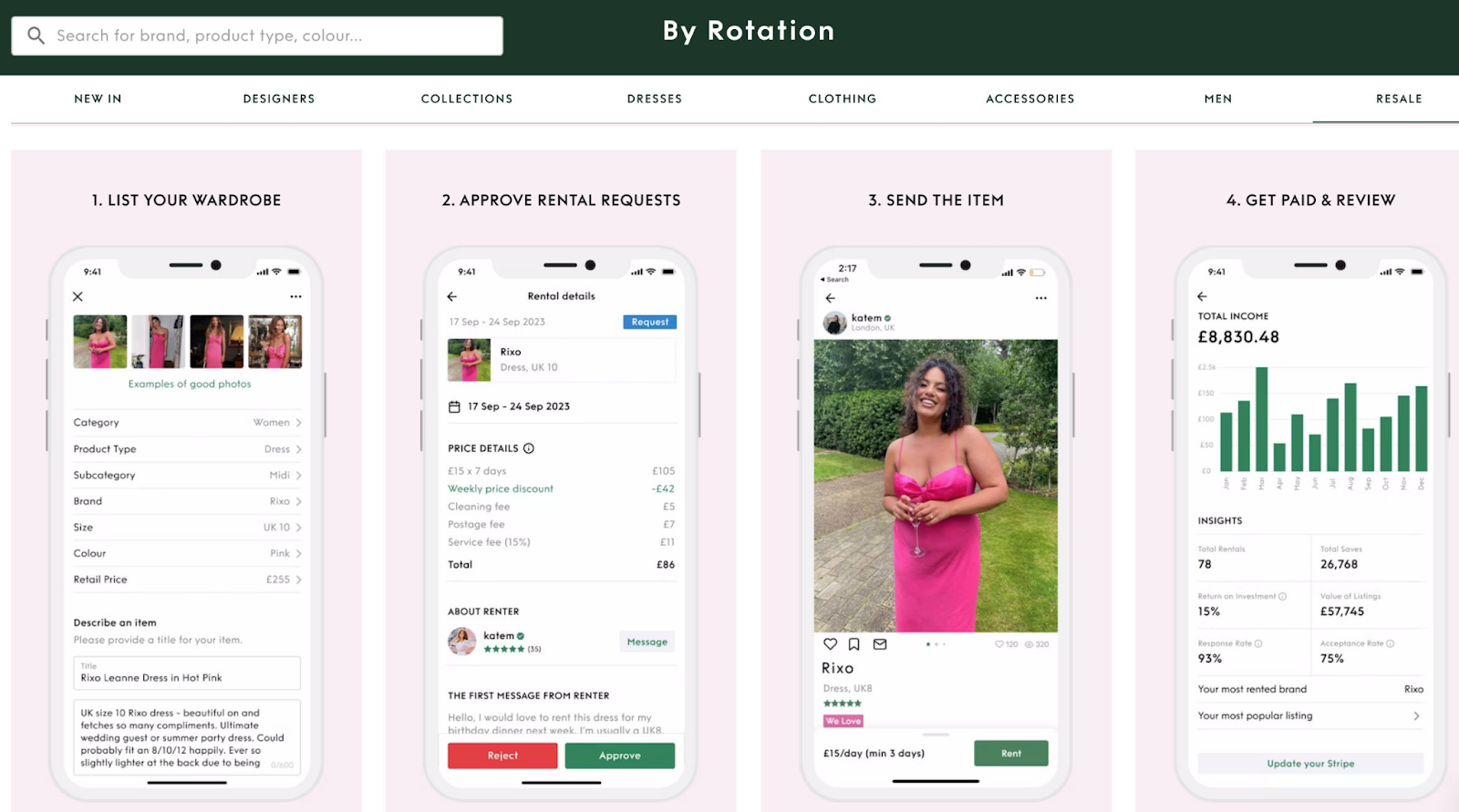
British entrepreneur Paula Pimlott makes around $5,000 per month on clothing rental platforms. She started by listing her clothes and later bought items to rent out.
Go Green
The eco-friendly ecommerce niche focuses on sustainability, a growing trend among consumers worldwide. Consider selling eco-friendly versions of existing products like Clearalif, a brand that makes low-waste laundry products.
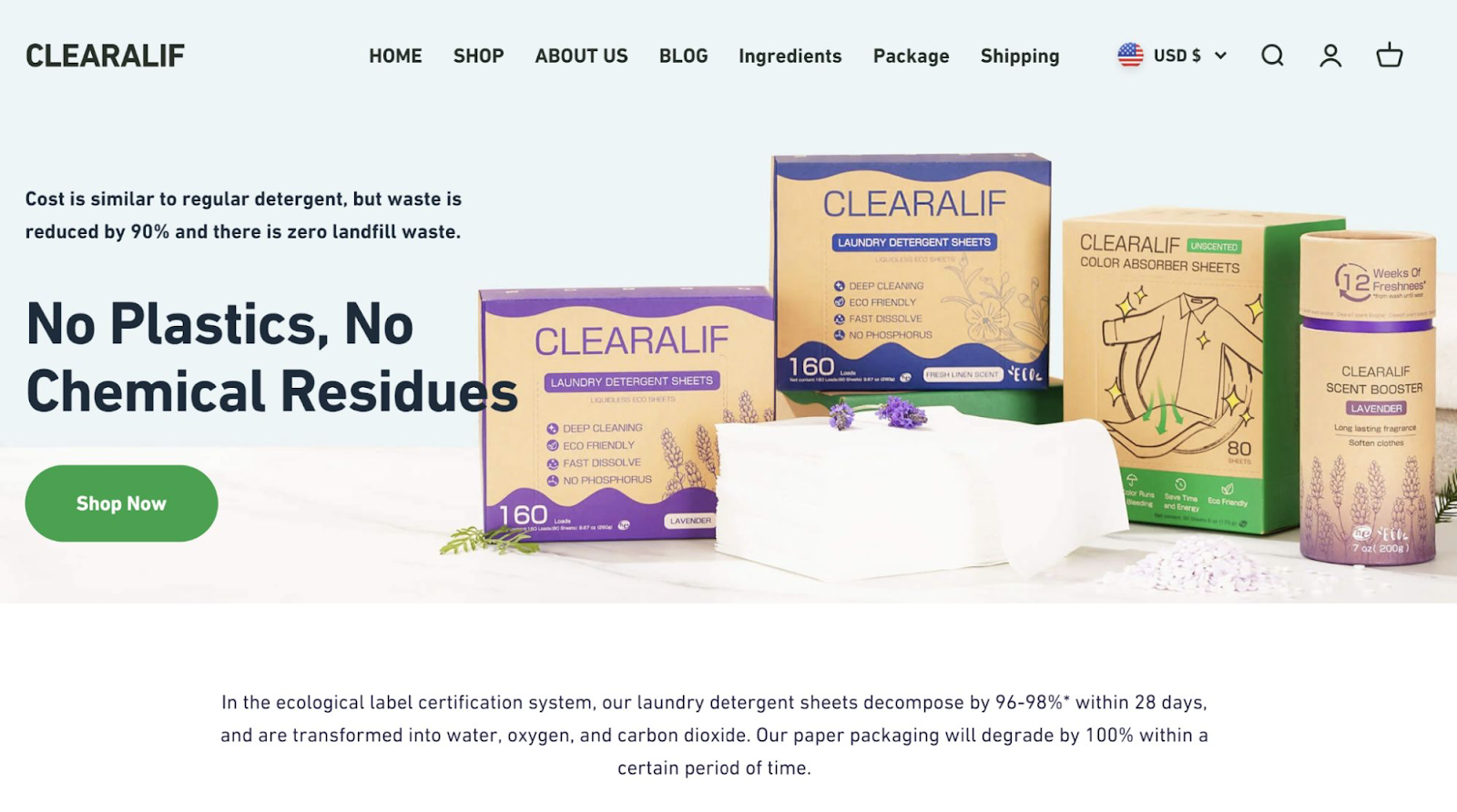
A 2021 survey conducted on 10,281 people in 17 countries including the U.S., found that 85% of consumers have taken steps toward being more sustainable. About 34% of respondents said they would pay more for eco-friendly products.
Here are some product ideas, depending on your target audience and business goals:
- Sustainable coffee
- Recycled activewear
- Reusable water bottles
- Vegan pet accessories
- Compostable bowls
- Reusable lunch wraps
- Green cleaning products
- Cotton shopping bags
- Eco-friendly dining mats
- Organic personal care products
Sell Refurbished Electronics
Have you ever heard of Amazon Renewed or the eBay Refurbished Program? These online platforms connect buyers with sellers offering second-hand products, including refurbished electronics.
The latter category includes products returned to a vendor or used as store display items. They are thoroughly tested and undergo necessary repairs before selling. Since they are used, they have a lower price tag than a new product.
For example, DKOldies is an ecommerce company out of Pennsylvania that sells refurbished classic video game consoles.
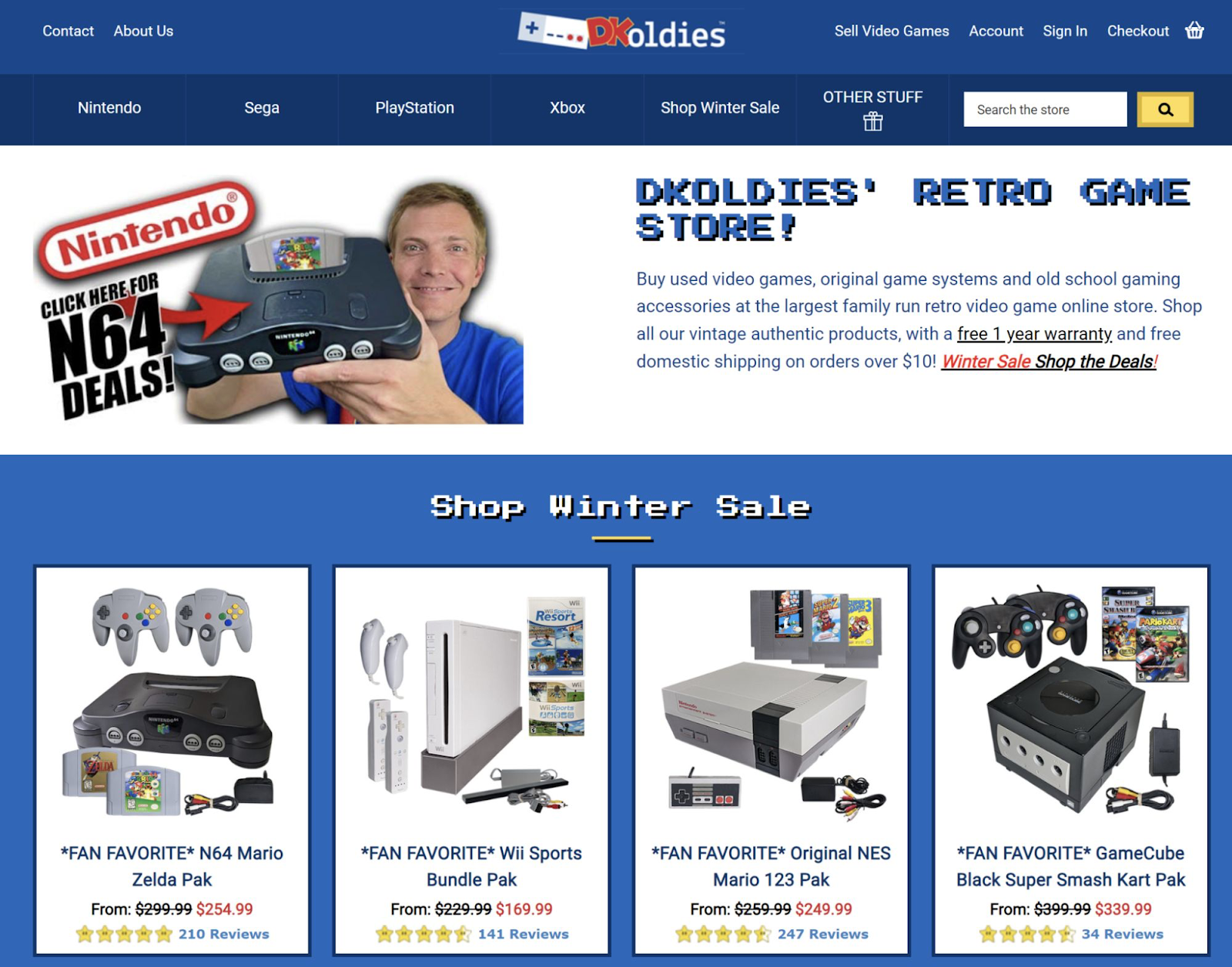
Buy these products from authorized retailers or suppliers and sell them online for a profit. Here are a few examples:
- Refurbished smart home products
- Electric scooters
- Fitness trackers
- Laptops and desktop PCs
- Smartphones
- Gaming monitors
- Kitchen appliances
Acording to a YouGov survey conducted on 19,000 people across 18 countries, 28% of consumers worldwide have bought refurbished or recycled electronics. Another 41% said they would consider purchasing such products. These numbers were highest in the UK, the U.S., and Canada.
Shoppers also buy used items for sustainability purposes. Refurbished electronics can help reduce e-waste and contribute to a cleaner environment.
Sell Women's Health Products
One way to make a difference through your work is to help women cope with the challenges of pregnancy, motherhood, PMS, and menopause. Think about menstrual cups, prenatal supplements, UTI test strips, and other popular products.
The women's health market was worth $44.36 billion in 2023, and continues to grow. This industry is fueled by innovation and changing lives. It’s also worth mentioning that 18% of U.S. consumers bought drugstore and health products in 2023, per Statista.
British entrepreneur Hannah Samano launched Unfabled, an online marketplace for menstrual care. Customers can purchase menstrual cups, CBD organic tampons, period pants, plastic-free pads, and other niche products from top brands.
What sets Unfabled apart is its emphasis on sustainability and innovation within the menstrual care niche. Here's what the store looks like:
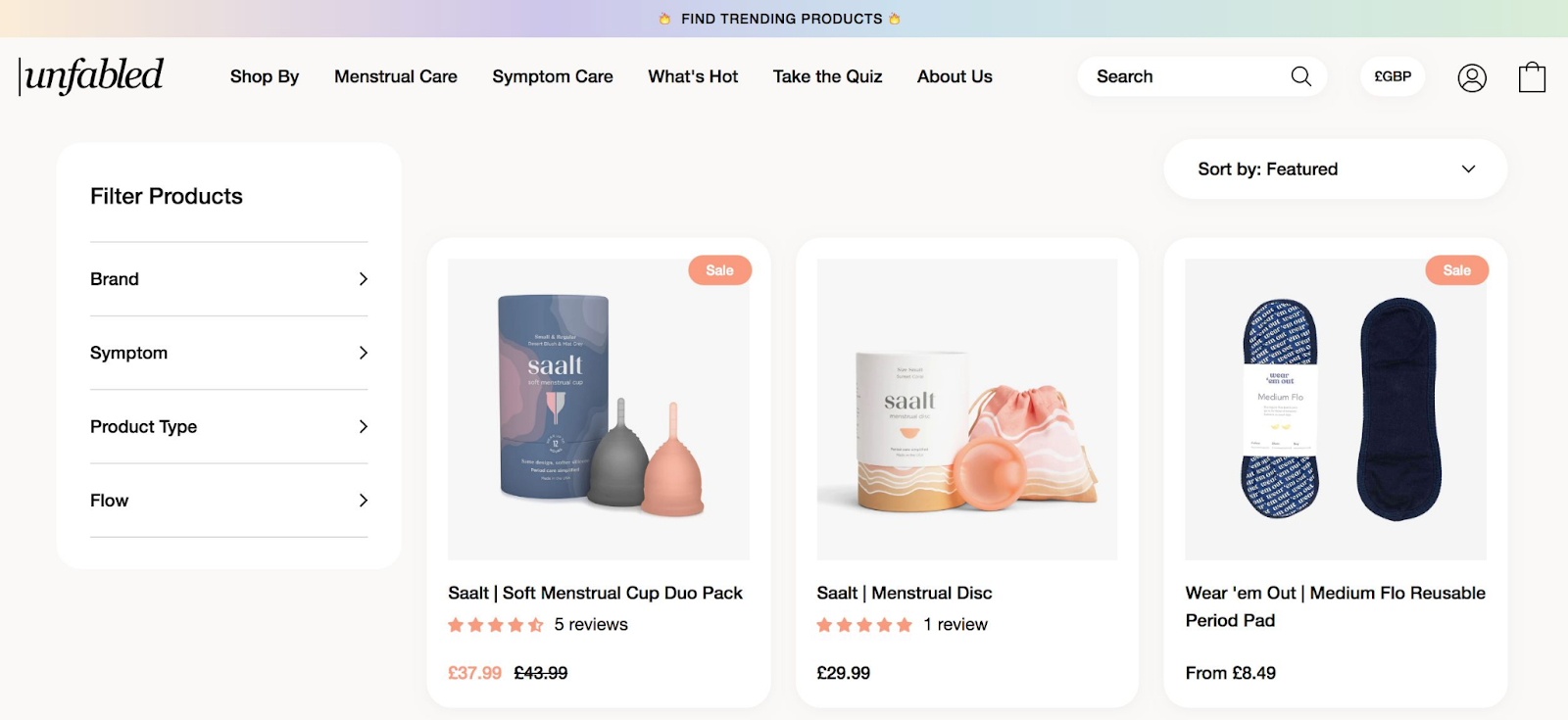
Similarly, set up an online shop and sell niche products for women. Consider offering complementary services, such as virtual access to OBGYNs, free education, or virtual maternity classes.
Further reading: 14 Ecommerce Tools for a Successful Online Shop
Flip Children’s Toys
According to Statista, 14% of consumers bought toys and baby products in 2023. In fact,the average family in the U.S. spends around $600 on toys each year.
It's a large market, as children get easily bored and love the stimulation of new toys. This phenomenon drives the market forward.
How do you find children's toys to sell? Attend garage sales, check Facebook Marketplace, and scour eBay listings to find pre-loved toys to restore. List them for sale on your website or online platforms like Etsy, Amazon Renewed, and Goodbye Gear.
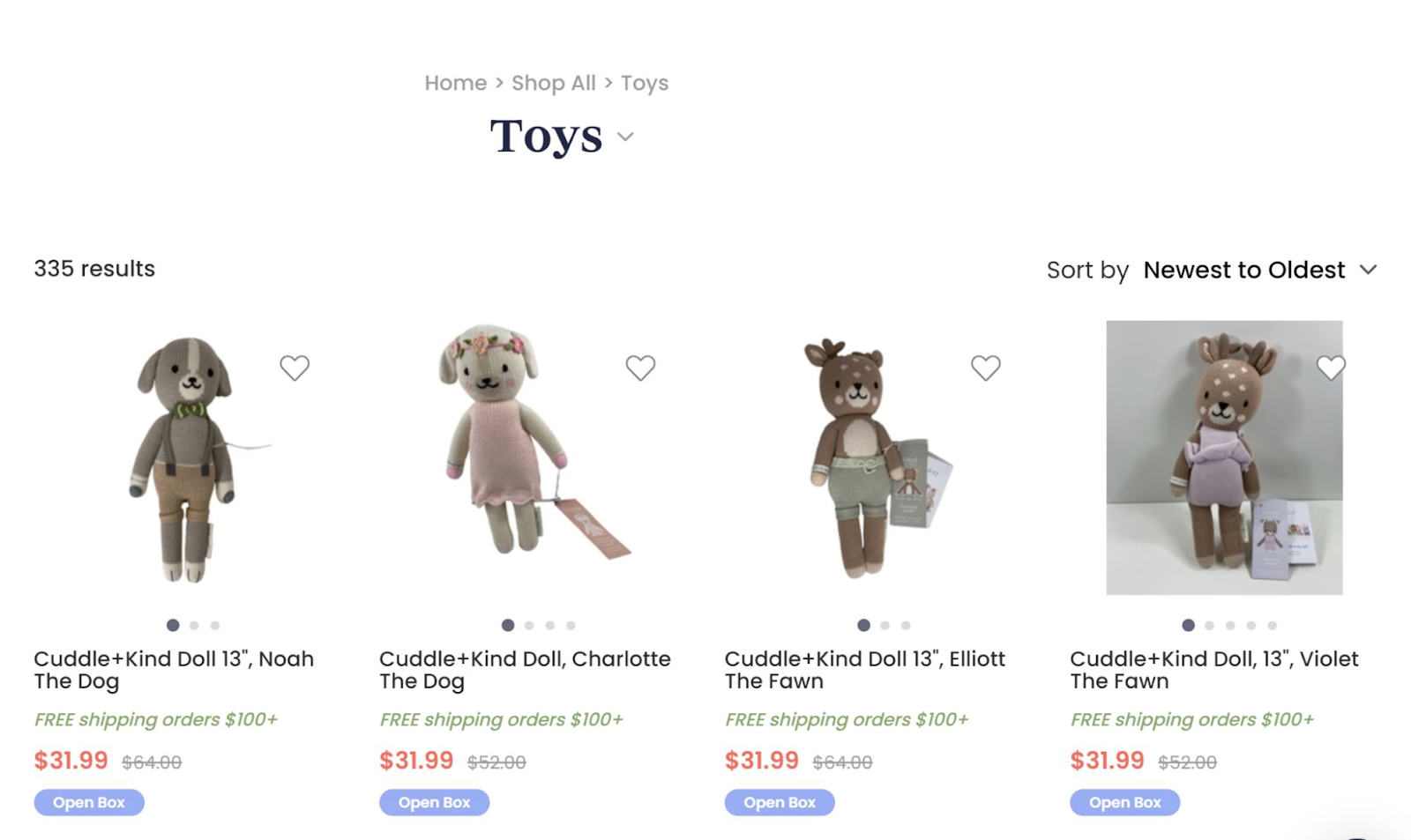
This business model is appealing because you can buy the toys for next to nothing and restore them to raise their value.
To narrow down your market, focus on specific niches, such as vintage or educational toys.
Capitalize on the Fitness Craze
Selling fitness equipment, courses, or on-demand coaching sessions might be one of the best ecommerce businesses to start this year.
The fitness industry is highly competitive. Sell physical or digital products targeted to specific customers to break into the market. Below are some examples:
- CrossFit equipment for at-home workouts
- Portable fitness equipment for travelers
- Smart water bottles with hydration reminders
- Recovery tools like massage guns, TENS units, and red light lamps
- Knee wraps, back braces, cold packs, and other rehab products
Ben Francis founded Gymshark in 2012 when he was in college. He started by purchasing bulk sports supplements to sell on his website. Later, he bought a sewing machine and a screen printer and launched a fitness apparel line.
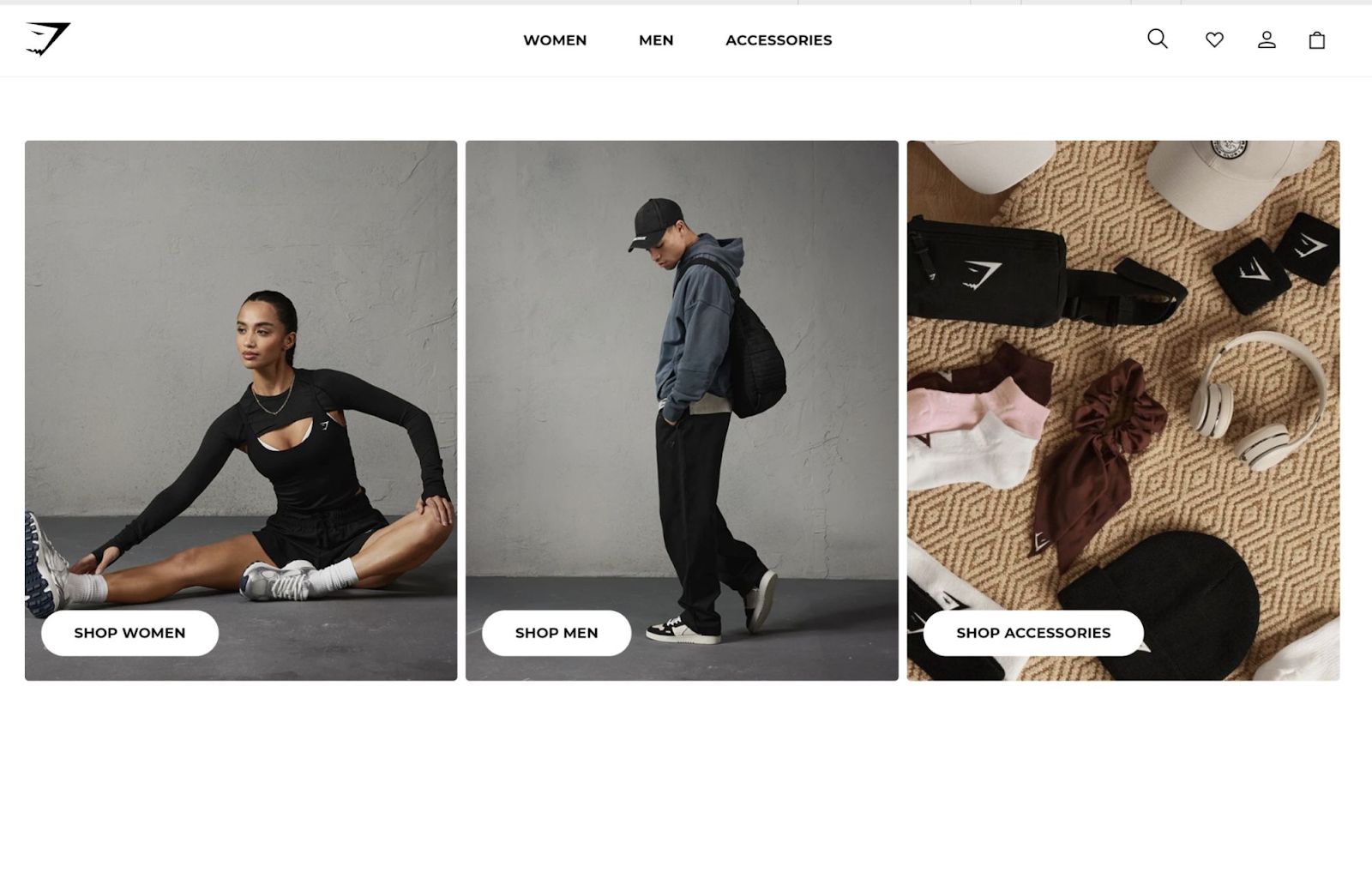
As of 2022, Gymshark was worth approximately 349 million British pounds. That's quite impressive for a business that started in a garage.
Break Into the Pet Industry
About 70% of U.S. households own a pet, according to a 2021-2022 Insurance Information Institute. Sixty-nine million households own a dog, and 45.3 million have cats.
Given these numbers, it’s no surprise that 22% of American consumers bought pet products in 2023, as reported by Statista.
Pet parents want the best for their four-legged companions. Your business could provide them with innovative products or services like:
- GPS dog collars and activity trackers
- Interactive puzzle feeders
- Themed subscription boxes
- Automated ball launchers, smart pet doors, or pet cameras with treat dispensers
- Natural and organic products
- DIY grooming kits
- Virtual dog training classes
- Telemedicine services
- Custom meal plans
If you're the creative type, consider offering personalized pet portraits (you can also do this with print-on-demand vendors). Or make needle-felted versions of dogs, cats, birds, or other animals.
Another option is to build an online platform for booking pet grooming services. Or create an online community or app to assist in the recovery of lost pets.
For example, PetSmart offers virtual dog training sessions in addition to other services. Pet parents can book a 30-minute introductory sessions or packages consisting of four or eight sessions.
These services are delivered via Zoom and can be tailored for each customer based on their pet’s needs.
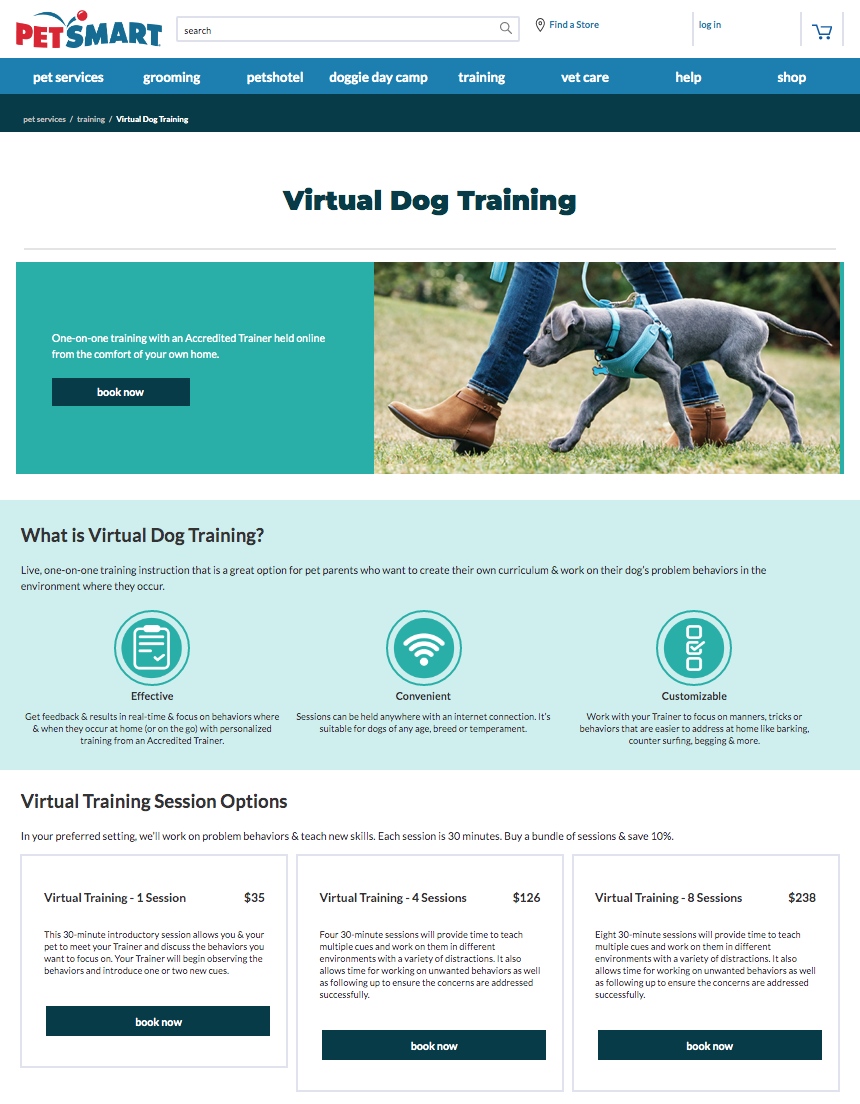
If you go this route, you’ll first need to become a certified dog trainer, which requires completing online or in-person courses. After that, you’ll set up a website or Facebook page to list and promote your services.
Further reading: 9 Profitable Ecommerce Business Ideas for Your Next Venture
Sell Subscription Services
Many consumers prefer to receive their go-to products or services automatically rather than purchase them a la carte. There are monthly subscriptions for everything from razors and tee shirts to stock tips and video streaming.
The global subscription market generated $72.91 billion in 2021. This industry has a compound annual growth rate (CAGR) of 62.61%. It's expected to reach $320.04 billion by 2027.
Ecommerce stores can use the subscription business model to drive repeat sales. Many brands also reward subscribers' loyalty with discounts, freebies, or extra services, so it's a win-win for both parties.
If you're a beauty retailer, sell subscriptions to skincare products or makeup kits. An online food store could sell meal box subscriptions to help customers save time in the kitchen.
Cratejoy offers subscription boxes for arts and crafts from sellers worldwide. Customers can subscribe to painting, knitting, or sewing supplies and similar products starting at $9.92 per month.
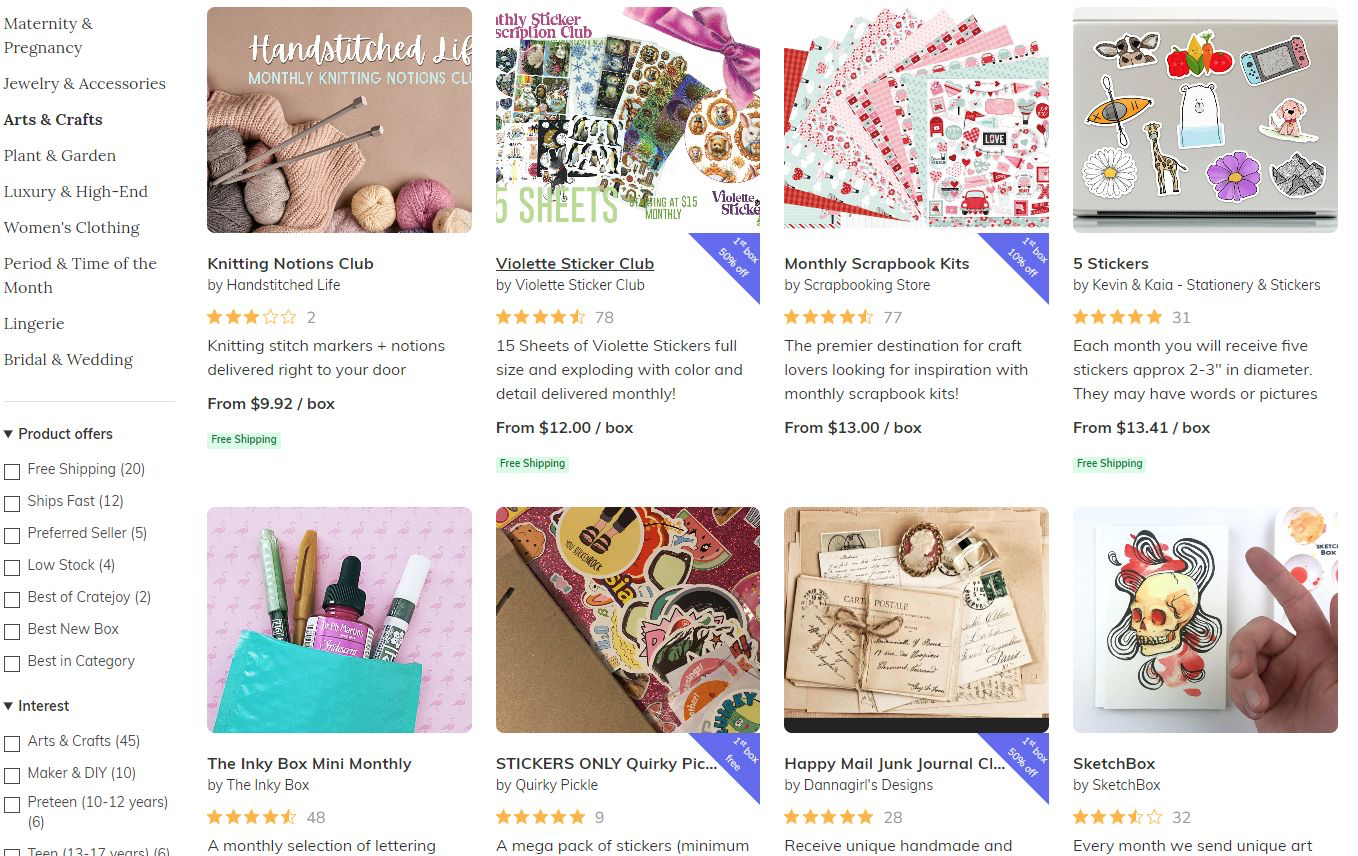
This business model allows you to generate recurring revenue, making it easier to plan things long-term. Simply put, you’ll have a more predictable stream of income compared to one-time sales.
It’s also worth mentioning that, in 2023, 12% of U.S. consumers bought stationery and hobby supplies online, per Statista research. You could reach an even larger audience by shipping your products worldwide through a fulfillment company.
Starting an Ecommerce Business
We discussed some good ecommerce business ideas. Nailing down an idea is the first step. Next is turning your idea into a profitable venture. Here's how to start an ecommerce business.
Begin with Market Research
First, define your ideal customers' needs and pain points. The more you understand their thoughts, desires, and behaviors, the more connected and effective your product and messaging.
Customer data can come from multiple sources, such as:
- Industry reports
- Government agencies
- White papers
- Polls and surveys
- Focus groups
- Interviews
- Social media platforms
- Your website or blog (if you have one)
- Loyalty programs and newsletters (after you launch)
Also research your competitors. Check their financial data and browse their websites and social media pages to see how they promote their offerings.
Meanwhile, research your desired market to see what's trending, what consumers value, and where your competitors fall short.
Further reading: Market Research: What It Is & How to Do It
Choose an Ecommerce Business Model
Ecommerce businesses can take many forms, depending on how you plan to produce, sell, and ship your products.
Let's discuss a few examples:
- Direct-to-consumer (D2C): Customers buy products directly from you without intermediaries
- Dropshipping: You outsource order fulfillment to a third party, such as Alibaba, AliExpress, or Megagoods. You don't need to store, package, or ship the products yourself. The dropshipper acts as a middleperson between retailers and customers.
- White label: You purchase products from a third party and sell them under your brand name as is, without any customization or modification. These are usually goods like tote bags, coffee mugs, T-shirts, or reusable water bottles.
- Private label: A third party manufactures and customizes products based on your requirements and instructions. You sell them under your brand name.
- Subscriptions: You charge a recurring fee for access to specific products or services
Other ecommerce business models include wholesaling (sell products to businesses that resell them to consumers), franchising, brokerages, print-on-demand (discussed earlier in this article), digital product sales, and more.
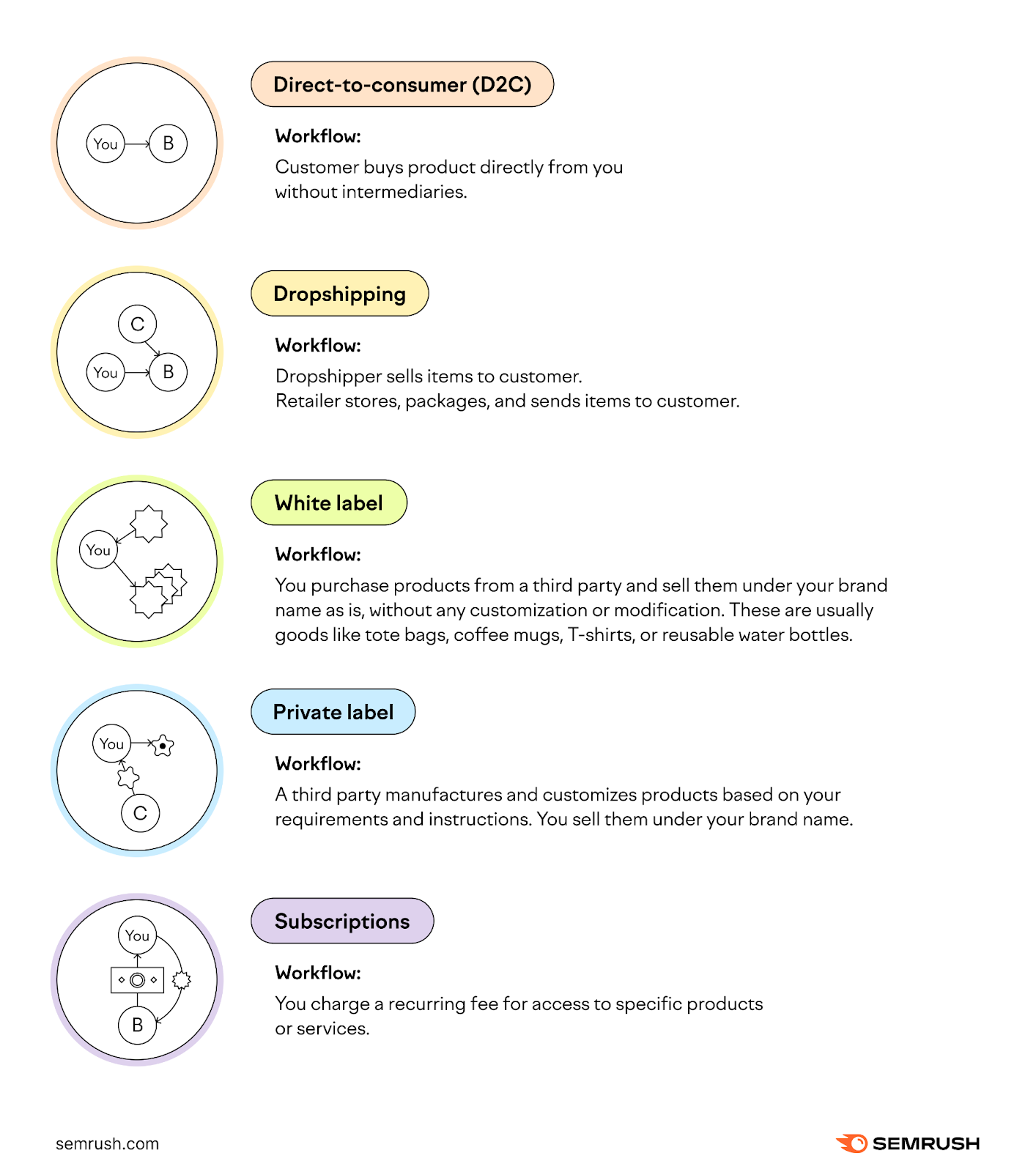
The best choice depends on what you sell, who you sell to, and your resources, among other factors.
For example, an online store offering natural products for mature skin could operate under a white-label agreement.
White labeling would allow you to sell high-quality face creams, serums, and similar products under your brand name, but without producing them in-house or making any changes to how the products are manufactured. You won't need to buy or rent a manufacturing facility and employ factory staff, which could decrease costs.
Or, if you have the capital and resources to create a custom product, go the private label route.
Maybe you want to sell graphic-printed apparel with your designs but don't have the resources or budget to buy and hold inventory. Take advantage of print-on-demand via dropshipping.
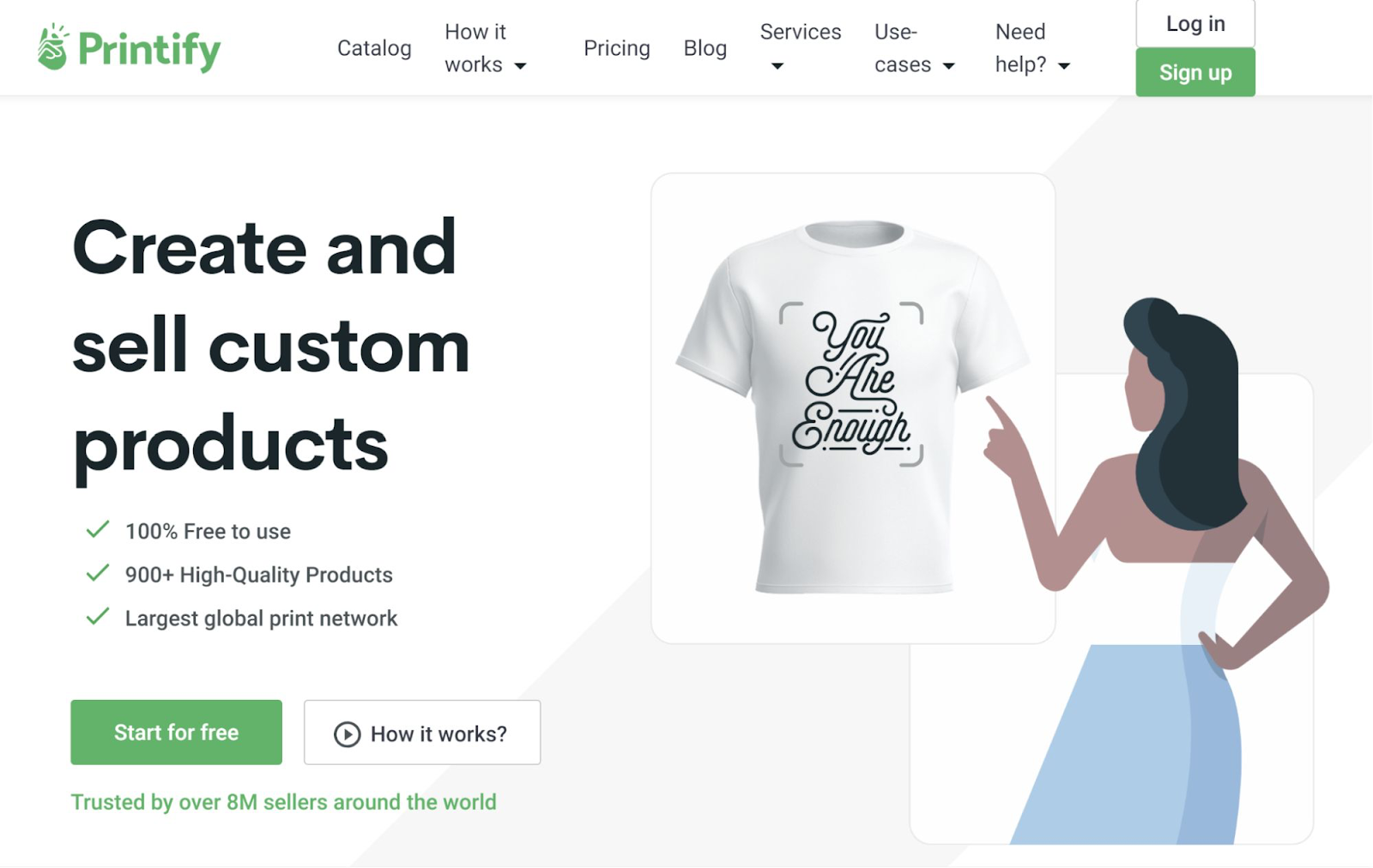
Draft a Business Plan
The next step is to create a business plan that outlines your goals, strategies, and value proposition.
The business plan is a roadmap. It highlights your idea's strengths and weaknesses, shows you the steps to building your business, and keeps you accountable.
This document usually includes the following elements:
- Executive summary (a brief description of your business idea, objectives, and other relevant aspects, such as your company's mission and values)
- Products and services (a detailed description of what you plan to offer)
- Market analysis
- Management and organization
- Marketing strategy
- Financial projections
- Funding needs
A business plan may increase your chances of building a successful venture by 16%. It can also help your startup perform better and grow faster.
Build an Ecommerce Website
Use an online store builder like Shopify, Wix, or BigCommerce to create your ecommerce website. Another option is WordPress combined with WooCommerce.
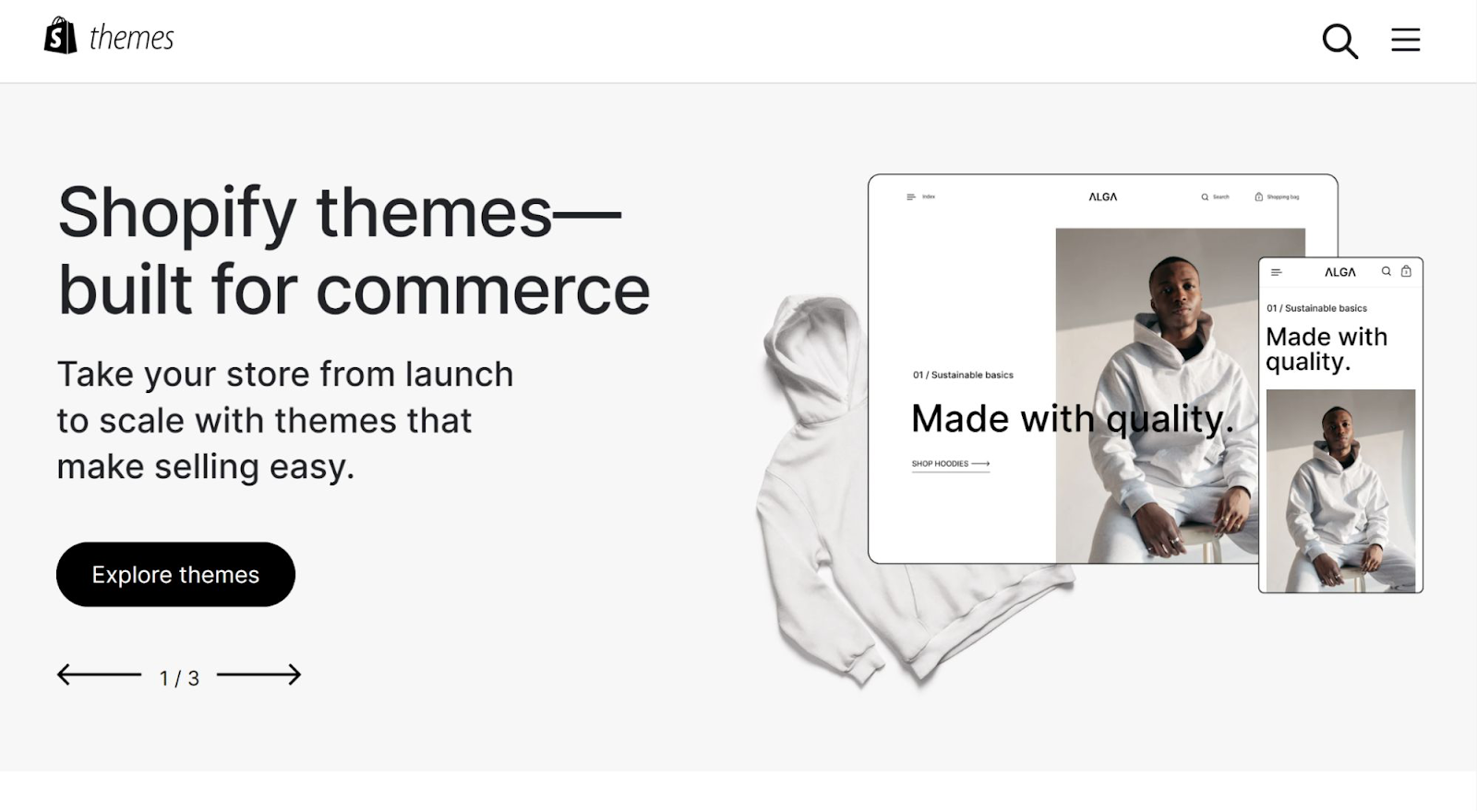
These platforms include content management tools, analytics tools, web hosting, pre-built templates, and other features. Plus, you can personalize your storefront and product pages, add content, and set up the navigation menu without writing code.
Make sure your website reflects your brand and resonates with your target audience. Also, it should be easy to navigate and look good on any device.
Mobile traffic accounted for 58.67% of all website traffic in the last quarter of 2023. Use a mobile-friendly layout and optimize your content for mobile as well as other screen sizes.
Here are other practices to consider:
- Keep your domain name short and simple (e.g., coffeecups.com). Short domain names are more marketable and easier to remember.
- If possible, choose a domain name ending in .com. This domain extension has a higher click-through rate and a more commercial feel than .org, .net, and other options.
- Use high-quality visuals on your site to improve the user experience. Visitors tend to stay longer on websites with beautiful imagery.
- Add a search bar to the homepage so customers can quickly find what they need
- Create clear categories and subcategories for each product type to improve website navigation
- Implement a "Quick Preview" option for the products displayed in search results. Users can quickly view a product without opening a new page or leaving the product category page.
- Follow a consistent layout for product category pages, individual product listings, and blog posts
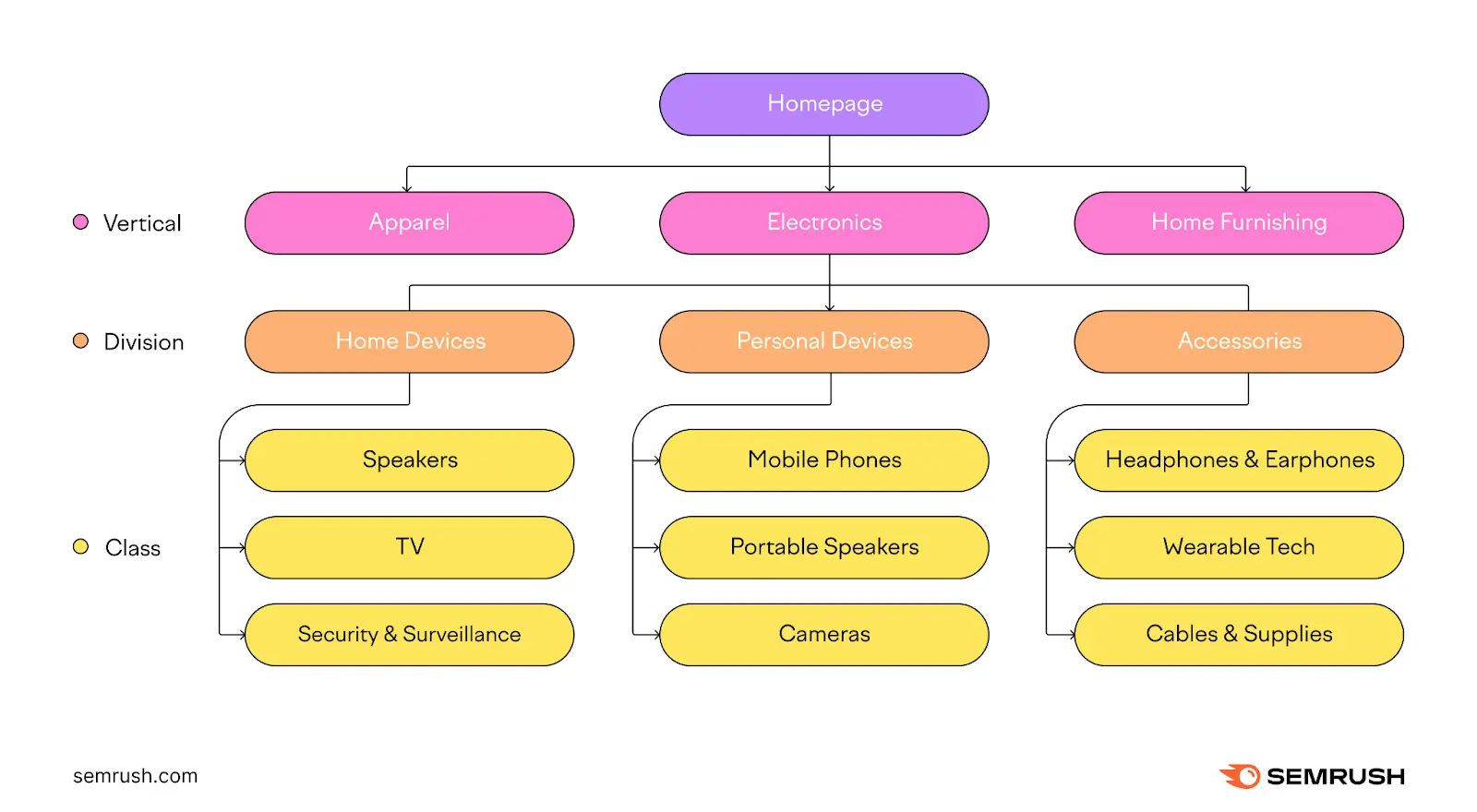
Further reading: The 9 Best Ecommerce Website Builders: A Comparative Review
Source Your Products from Reliable Suppliers
Reach out to multiple suppliers before ordering products for your online store. Depending on the product type, you could order a trial run or ask for samples.
Research the vendors you're interested in. Check their financials, read customer reviews, and find out whether they're affiliated with any trade associations or government agencies (which is a sign of trust).
Don't base your decision on price alone. Consider the product quality, customization options, shipping speed, and minimum order requirements.
For example, some suppliers have a minimum order quantity of 1,000 units. But if you're on a budget or want to try out a new product, you could start with a sample, or test a smaller amount on new customers.
Create a Digital Marketing Strategy
Digital marketing is the practice of promoting a brand or product online. It encompasses multiple processes, including, but not limited to:
- Search engine optimization (SEO)
- Pay-per-click (PPC) advertising
- Content marketing
- Social media marketing
- Email marketing
- Affiliate marketing
- Influencer marketing
Take SEO, for example. This practice involves optimizing your website for search engines.
A good starting point is to identify relevant keywords for your online store. Consumers use keywords to find information, products, or services on the web.
Use Semrush's Keyword Magic Tool to determine which search terms you should use to get more traffic and brand exposure.
The Keyword Magic Tool features an extensive database of approximately 25 billion keywords. Not only does it provide keyword suggestions based on your search, it also displays their ranking difficulty and other data.
Let's say you sell handcrafted candles. First, think of a keyword related to your business. This could be something like "handcrafted candles," "handmade candles," or "natural candles."
Next, access your Semurush dashboard and select the Keyword Magic Tool from the left-side navigation menu. Find it listed under "Keyword Research."
If you don't have a Semrush account, visit our website and click "Features" from the top navigation bar on the homepage.
Now click "Keyword Research."
Semrush will redirect you to a new page featuring several keyword research tools. Locate the Keyword Magic Tool and click "Try It Free."
The next step is to register for a free Semrush account. Sign up with Google or enter your email address and a strong password.
When you're done, click "Create account."
Log into your account and access the Keyword Magic Tool from the left-side navigation menu. Enter your seed keyword in the search bar. Your seed keyword is the main search term on which you'll base your research. Say you decide to use "handcrafted candles." Enter it into the tool, choose your target market, such as “United States” or “United Kingdom,” and click "Search."
Semrush will generate a list of search terms related to your seed keyword.
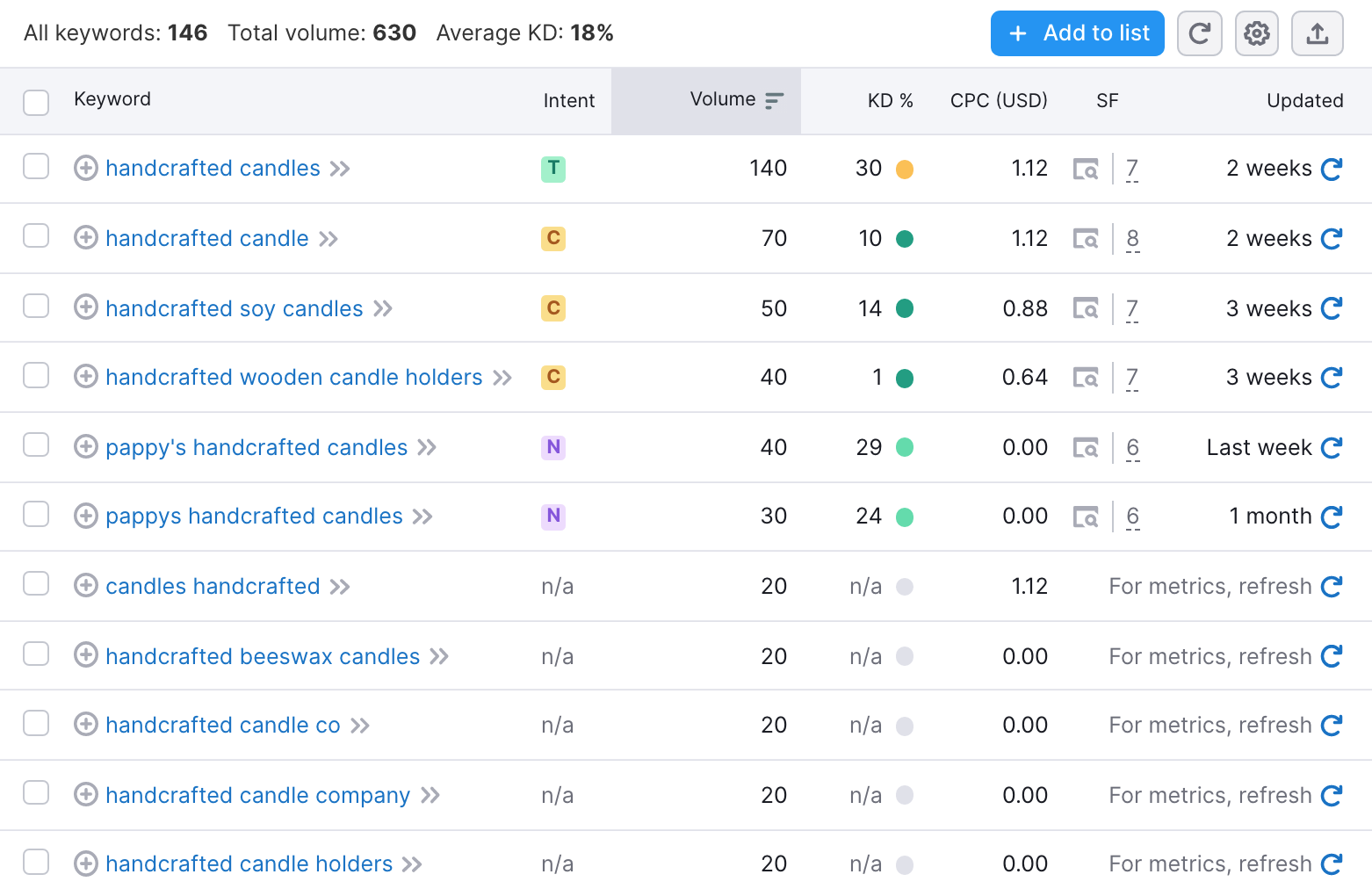
Our tool will display the average monthly searches for each keyword under "Volume." It also shows the keyword difficulty (“KD %”), which indicates how hard it would be for your site to rank in Google's top 10 results for a given search term.
Next, filter the results by search volume, keyword difficulty, number of words, or other criteria to narrow down your options. Ideally, look for keywords with at least 100 monthly searches and a KD of 0-49%.
Select these options from the navigation bar above the keywords list and click "Apply."
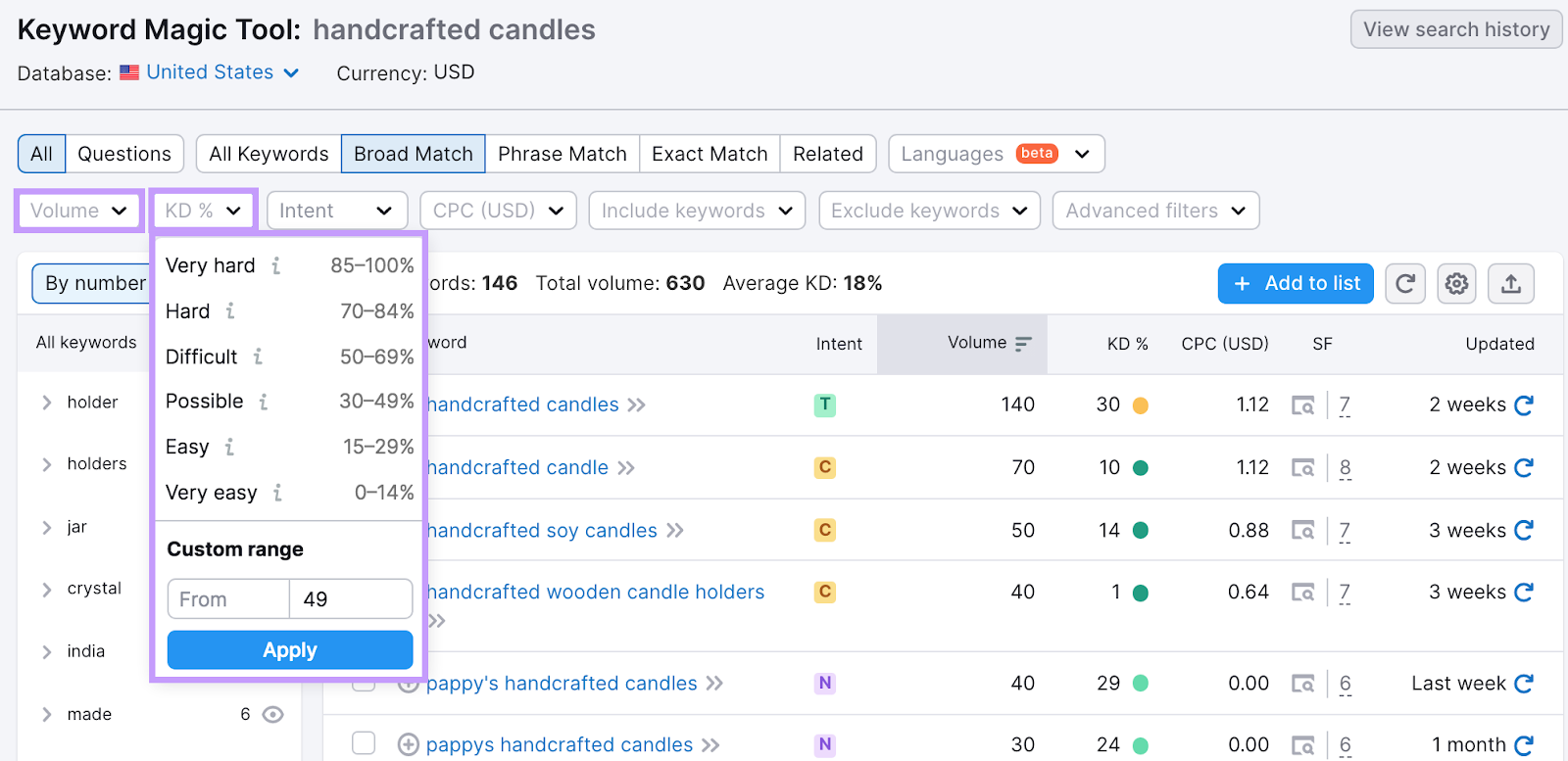
Based on our data, some good choices would be "handcrafted candles," "handcrafted candle," "handcrafted soy candles," and a few other search terms.
Choose a primary keyword, or the main search term, and place it strategically throughout your website. Also use secondary keywords, which are usually longer and more specific words and phrases related to the primary search term (i.e., handcrafted soy candles).
Optimize each page for one primary keyword (e.g., "handcrafted candle). Use it in the following locations:
- Page URL
- Page title
- Product title
- Page or product description
- At least one subheading (if applicable)
- Image alt text and captions
- Copy
Use secondary keywords throughout the content where appropriate.
Similarly, optimize your blog, social media posts, and online ads for your target keywords. This practice can boost your visibility and contribute to higher rankings over time.
Avoid going overboard with keywords, however. Keyword stuffing, or the excessive use of keywords, goes against Google's spam policies and may lead to lost rankings.
Go one step further and use the Semrush Site Audit tool to review your website.
Site Audit performs over 140 on-page and technical SEO checks to identify issues that could affect your search engine rankings.
It can detect duplicate content, slow-loading pages, broken links, incompatible plugins, and other problems. The Semrush Site Audit tool will also show you how to fix these issues.
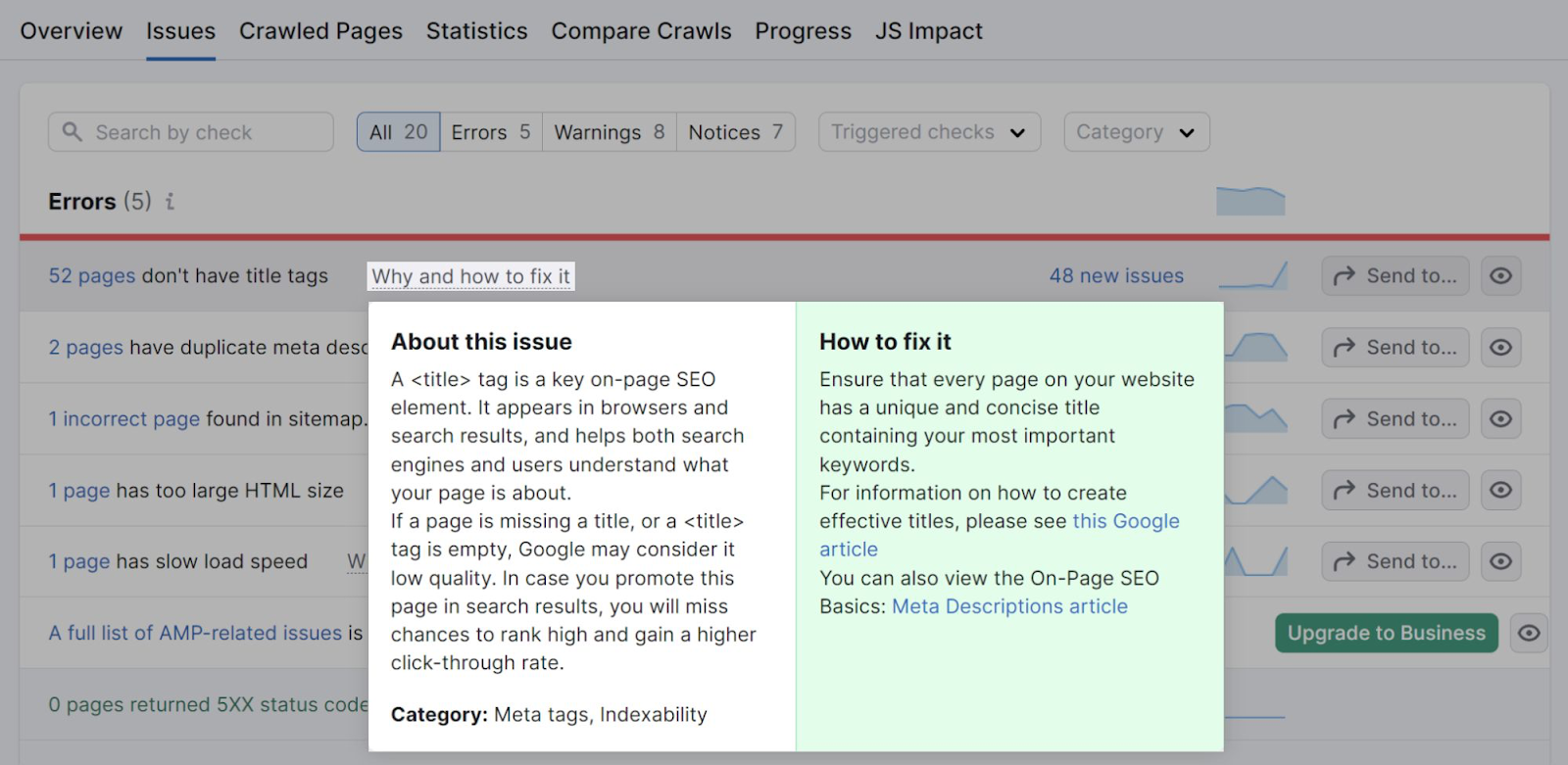
Addressing these problems will make your website more SEO-friendly and avoid search engine penalties.
Further reading: Ecommerce SEO: A Simple Guide for Beginners
Strive for Customer Service Excellence
How do you become more customer-centric? Put customers at the heart of your business and go above and beyond to meet their needs.
A PwC survey found that 73% of buyers admitted that customer experience influences purchase decisions. Approximately 42% said they'd pay more for a welcoming experience, and 63% would share more information with a brand that meets their expectations.
PwC also found that 80% of U.S. consumers value speed, convenience, and friendly service when engaging with a brand.
Here are some tips:
- Personalize your newsletters, product recommendations, and website content for individual buyers and customer groups. Use audience data to deliver customized experiences at every touch point.
- Drive engagement by implementing a chatbot to handle customer inquiries around the clock.
- Interact with your audience on social media. Reply to their comments, answer their questions, and act on their feedback.
- Leverage customer reviews to understand their needs and wants
Further reading: Content Personalization: What It Is & How to Do It
Comply with the Law
Launching an online store is similar to starting any other business, so it requires following the same laws.
Name your company and choose a business structure, such as a sole proprietorship, limited liability company (LLC), or S Corp. You may want to consult with a tax or business professional to see which decision is right for you.
Then, register your business, pay any associated fees, get a tax ID number, and open a bank account.
Other requirements may include:
- Apply for business licenses and permits
- Get general liability insurance and other coverage (depending on what you sell)
- Secure copyright protection for your website
- Apply for a trademark
- Comply with the General Data Protection Regulation (GDPR) and/or the California Consumer Privacy Act (CCPA)
For instance, retailers who purchase wholesale goods may need to apply for a reseller permit, depending on the local laws. Some states also require business owners to obtain sales tax permits.
Requirements vary from state to state and depend on your business structure and what you sell, among other aspects. Contact your local chamber of commerce or a lawyer before starting.
Leverage Analytics to Make Data-Driven Decisions
Once your business is up and running, track its performance by monitoring your website, social media pages, and other channels.
Use Google Analytics to see where your customers are coming from, how they find your store online, and how much time they spend on a page.
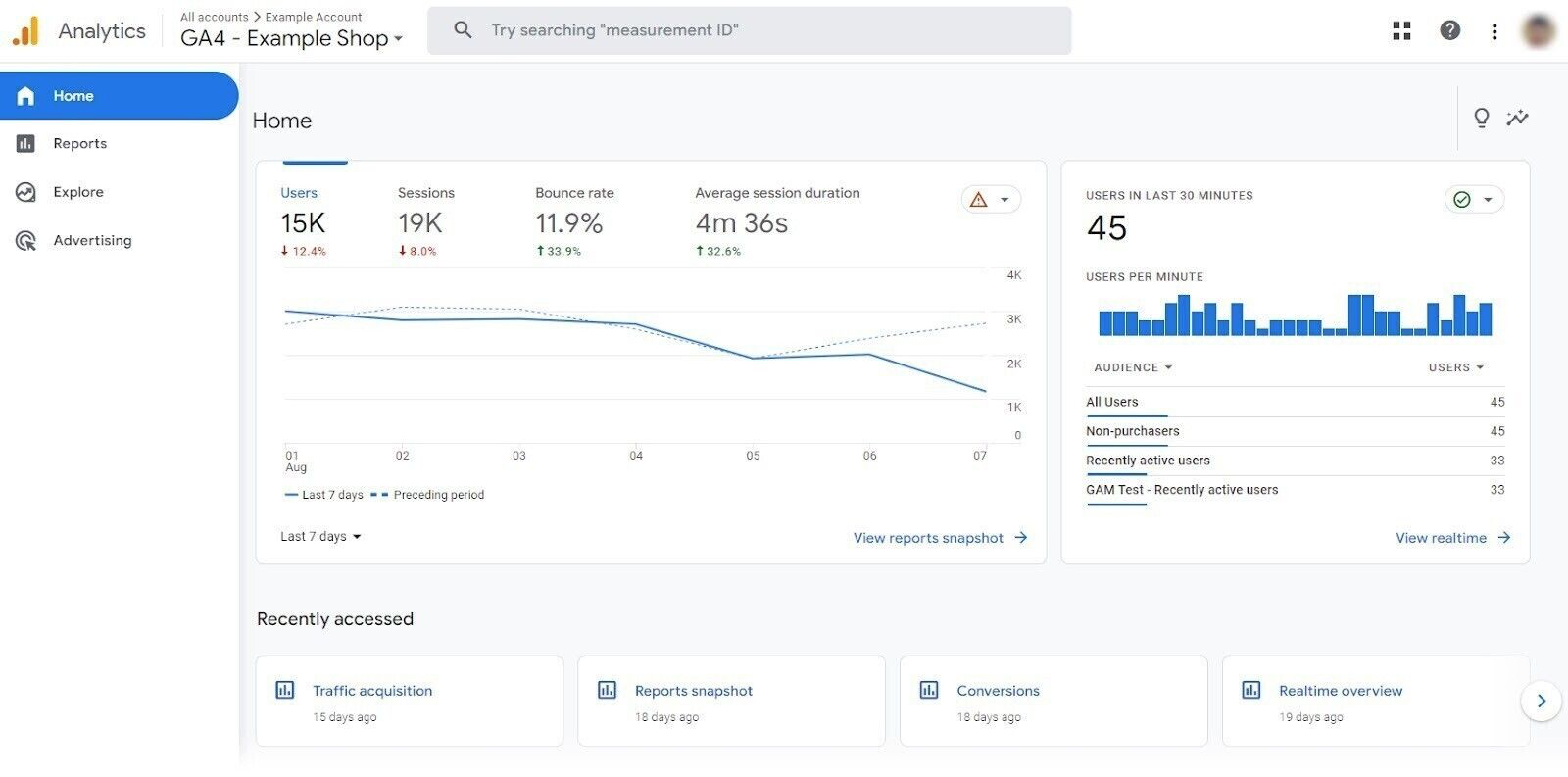
Monitor customer behavior and other data on social media and online marketplaces.
Amazon, eBay, Etsy, Shopify, and other platforms have built-in analytics tools for tracking your key performance indicators (KPIs), such as the average order size, conversion rates, and total sales.
Use these insights to learn more about your audience, refine your marketing strategy, and optimize your inventory.
Further reading: 16 Marketing KPIs You Need to Monitor in 2024
Scale Your Ecommerce Business
If you want higher profits, you'll need to scale up your business. Find ways to generate more revenue without significantly increasing costs.
One solution is to outsource marketing. Reach more customers and drive brand awareness without investing in new equipment or products.
Go one step further and leverage automation to streamline your operations.
For example, chatbots can automate customer service (or at least a big part of it) and free up your time. This would allow you to focus on your core activities and make more money.
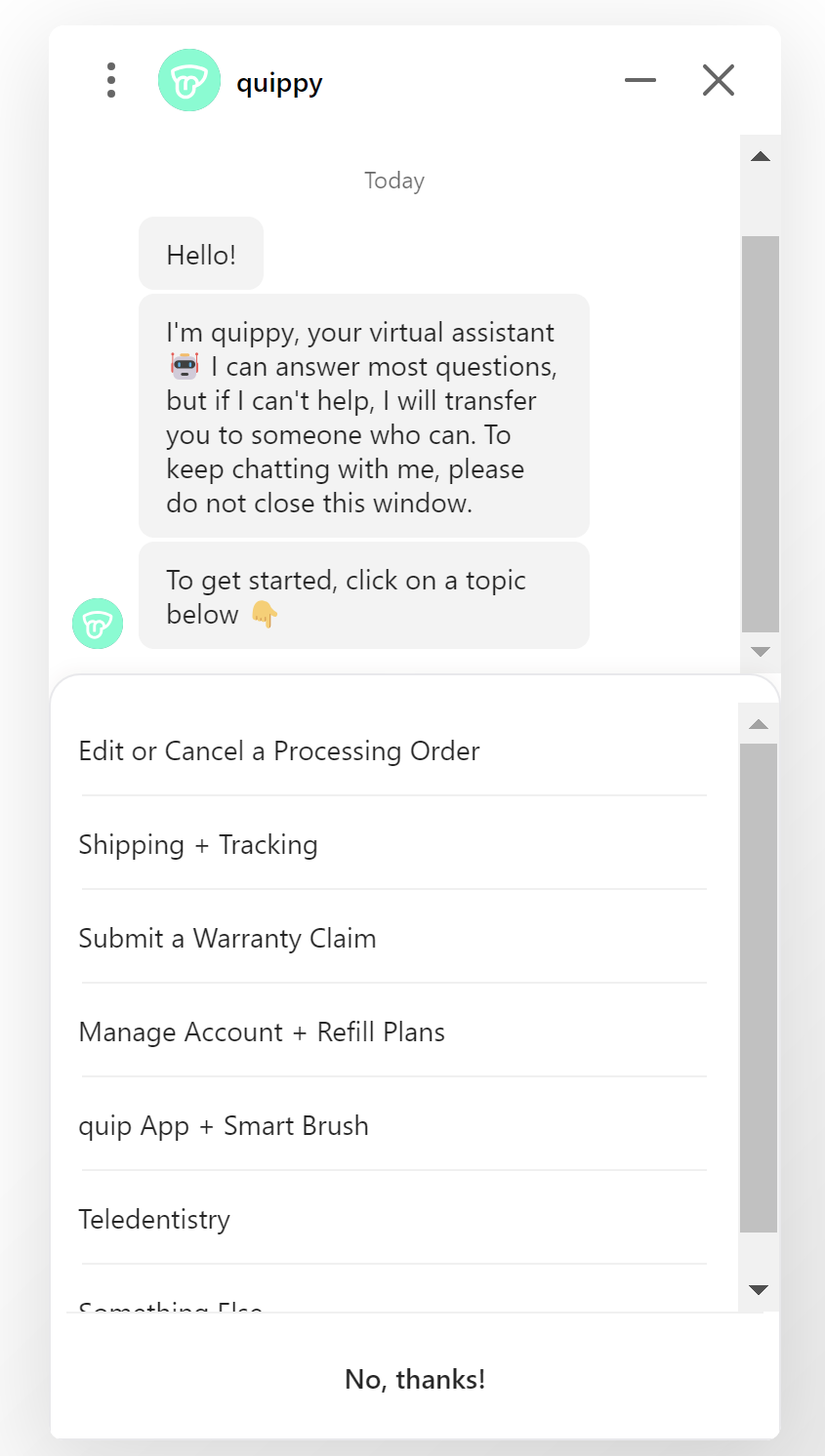
Source: Quip
Another option is to upsell or cross-sell your products and services. When customers check out, they'll see a pop-up window featuring a higher-end version or accessory of the product (e.g., upsell a handlebar phone holder for customers purchasing a bike).
Build a Successful Online Business
The best ecommerce business to start has growth potential and allows you to capitalize on your existing knowledge. Find a niche that aligns with your personal and professional goals.
However, coming up with a great business idea doesn't guarantee success.
You must also deliver a seamless shopping experience. Optimize your online store and web copy, deliver excellent service, and anticipate buyers' needs.
Some of the best ecommerce businesses use Semrush to continuously improve their marketing efforts. Sign up for a free account to get the tools you need to drive sales and scale your business.
